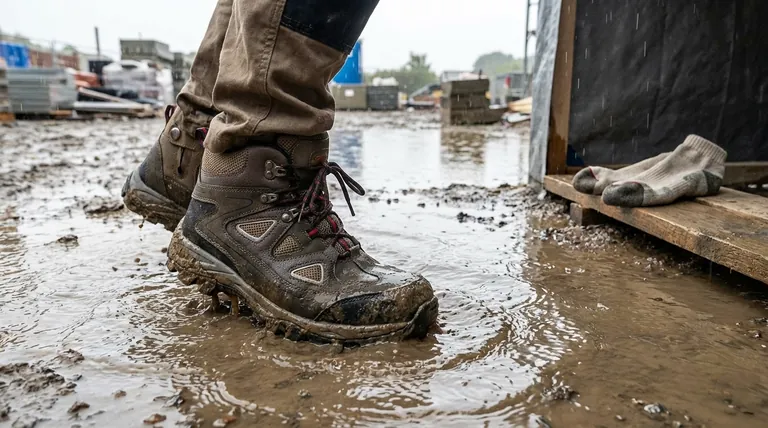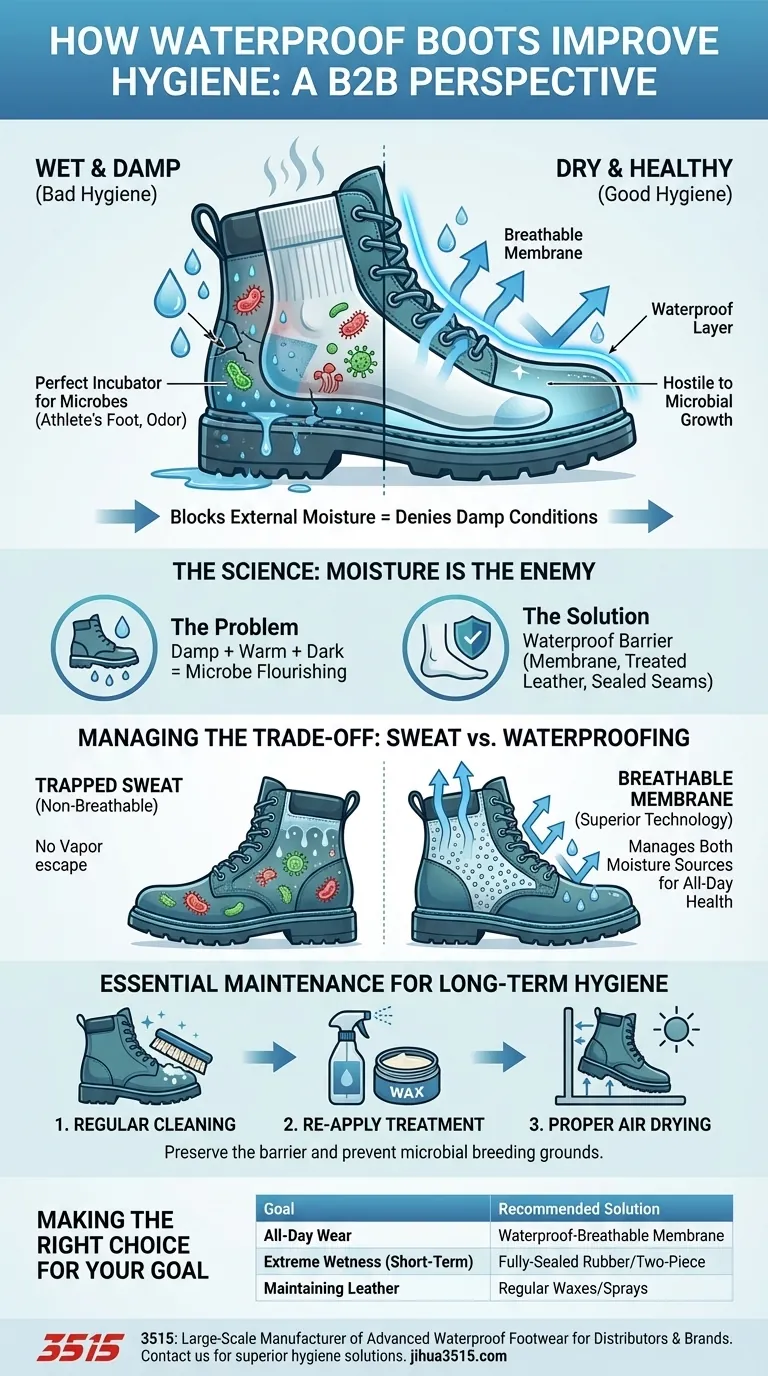At their core, waterproof boots improve hygiene by creating a dry internal environment that is hostile to the microbes responsible for infection and odor. By blocking external moisture from rain, puddles, or snow, they prevent your socks and feet from becoming saturated, which denies fungi and bacteria the damp, warm conditions they need to thrive.
The primary hygienic benefit of a waterproof boot is its ability to prevent the foot from sitting in a damp environment. This single function drastically reduces the risk of common fungal infections, like athlete's foot, and minimizes the growth of odor-causing bacteria.

The Science of Foot Hygiene: Moisture is the Enemy
To understand the benefit of waterproof boots, you must first understand why wet feet are a problem. The issue isn't the water itself, but the environment it creates inside your boot.
The Problem with Damp Environments
Fungi, such as the kind that causes athlete's foot, and various strains of odor-causing bacteria flourish in warm, dark, and moist conditions. A wet boot is a perfect incubator for these microorganisms.
How Waterproofing Creates a Barrier
Waterproof boots use a variety of methods to block external water. This can be a waterproof-breathable membrane (like a liner), leathers treated with oils and waxes, or sealed construction methods that prevent water from seeping through seams.
Preventing the Incubation Effect
By keeping the boot's interior dry from outside sources, you eliminate one of the key ingredients needed for microbial growth. This directly translates to healthier feet, less odor, and a significantly lower risk of fungal infections.
Not All Waterproofing is Created Equal
The term "waterproof" can describe several different technologies and construction methods, each with implications for both protection and hygiene.
The Role of Waterproof Membranes
Modern boots often feature a waterproof and breathable membrane between the outer material and the inner lining. This microscopic layer is engineered to block larger water molecules from entering while allowing smaller water vapor molecules (sweat) to escape.
Treated Leathers and Sealed Seams
Traditional boots rely on naturally water-resistant materials like oil-tanned leather and robust construction. Methods like a Goodyear welt or direct-attached soles must have waterproof seals or stitching to be effective, preventing leaks at the boot's weakest points.
Two-Piece vs. One-Piece Designs
Some heavy-duty boots use a two-piece design with a burly rubber lower and a leather upper for maximum protection in deep snow or mud. More common one-piece designs integrate the waterproofing directly into the boot's main body for a more seamless defense.
Understanding the Trade-off: Waterproofing vs. Breathability
The most significant challenge in footwear hygiene is managing moisture from two sources: the environment and your own feet. This creates a critical trade-off.
The Sweat Factor
A boot that is perfectly waterproof but not breathable (like a basic rubber boot) can be counterproductive for hygiene. It will trap all of your foot's perspiration, creating the very moist internal environment you are trying to avoid.
Why Breathable Membranes Matter
This is why waterproof-breathable membranes are a superior technology for all-day wear. They solve the trade-off by managing moisture from both inside and out, keeping your feet drier and healthier over long periods.
When Less Breathable is Acceptable
For short-term tasks involving extreme wetness, a fully-sealed, less-breathable boot can offer the best protection. However, it should be removed and dried thoroughly after use to prevent it from becoming a microbial breeding ground.
How to Apply This to Your Boots
Choosing the right boot is only half the battle. Proper maintenance is essential for preserving the hygienic barrier and extending the life of your footwear.
Regular Cleaning is Non-Negotiable
Start by removing caked-on dirt and grime with a stiff brush and a damp rag. Clogged pores in leather or fabric can compromise both water resistance and breathability.
Re-applying Waterproofing Treatments
For leather boots, periodically apply a sealant or wax, gently warming the leather first to help it absorb. For fabric or synthetic boots, finish with a quality waterproof spray after cleaning to restore the water-repellent coating.
The Importance of Proper Drying
Always allow your boots to air dry naturally after use, away from direct sunlight or intense heat, which can damage materials and adhesives. Ensuring they are completely dry before your next wear is a crucial step in preventing microbial growth.
Making the Right Choice for Your Goal
Your specific needs will determine which type of waterproofing provides the most hygienic benefit.
- If your primary focus is all-day wear in variable conditions: Prioritize boots with a waterproof-breathable membrane to effectively manage both external moisture and internal sweat.
- If your primary focus is short-term protection in extreme wetness: A fully-sealed rubber or two-piece boot offers maximum waterproofing but must be dried carefully after each use.
- If your primary focus is maintaining existing leather boots: Regularly clean and treat them with appropriate waxes or sprays to preserve their water resistance and structural integrity.
Ultimately, a dry foot is a healthy foot, and understanding how your boots achieve that is the key to comfort and hygiene.
Summary Table:
| Hygienic Benefit | How It Works | Key Feature |
|---|---|---|
| Prevents Fungal Infections | Blocks external moisture, denying fungi a damp environment | Waterproof barrier (membrane, treated leather) |
| Reduces Odor-Causing Bacteria | Eliminates warm, moist conditions bacteria need to thrive | Breathable membrane to manage sweat |
| Maintains Foot Health | Keeps interior dry, reducing risk of athlete's foot and other issues | Sealed seams and proper construction |
As a large-scale manufacturer, 3515 produces a comprehensive range of waterproof footwear for distributors, brand owners, and bulk clients. Our boots are engineered with advanced waterproof-breathable membranes and sealed construction to ensure superior hygiene and comfort. Whether you need all-day wear boots for variable conditions or heavy-duty protection for extreme environments, we have the expertise and production capabilities to meet your demands.
Ready to offer your customers healthier, drier feet? Contact us today to discuss your footwear needs and explore our diverse product range!
Visual Guide

Related Products
- Safety Footwear Wholesale Manufacturer for Custom OEM/ODM Production
- Premium Flame-Retardant Waterproof Safety Boots and Shoes
- Wholesale Premium Waterproof Nubuck Safety Shoes Boots
- Wholesale Safety Footwear Manufacturer for Bulk & Custom OEM Orders
- Durable Waterproof Rain Boots | Custom Manufacturer for Wholesale & Brands
People Also Ask
- What are the cultural perspectives on wearing shoes in the house? A Guide to Home Etiquette & Hygiene
- Is safety-toe as good as steel toe? Choose the Right Protection for Your Job
- Do snake bite boots work? Your Ultimate Guide to Effective Snake Bite Protection
- What cultural and environmental considerations are tied to wearing shoes indoors? Balance Hygiene, Tradition, and Foot Health
- What do heavy duty boots do? Protect Your Feet in Demanding Work Environments



















